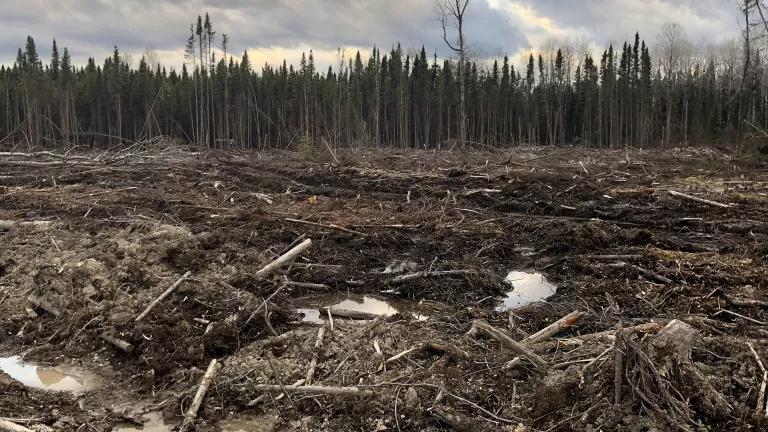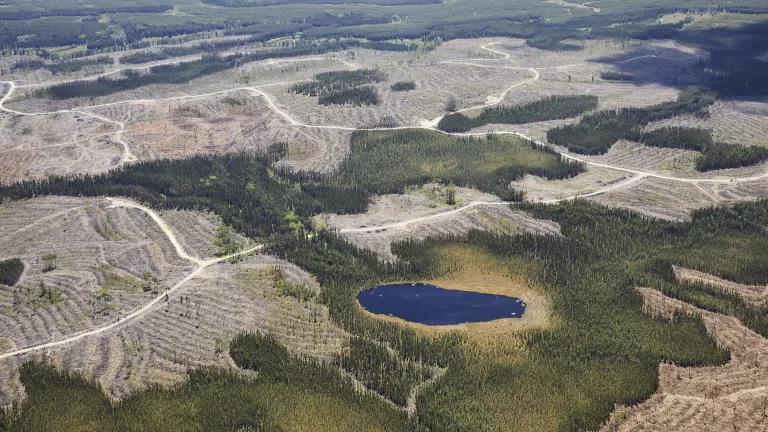Canada’s Accounting Artifice Masks Logging’s Climate Toll
A new report from NRDC, Nature Canada, Environmental Defence Canada, and Nature Québec illustrates that, through a series of accounting and regulatory loopholes, the Government of Canada has drawn a curtain over the logging industry’s carbon emissions, allowing the sector to escape scrutiny for its substantial climate impact.

A clearcut in Ontario
Driving across Canada’s boreal forest, it’s possible to be feet from a clearcut and never know it. Lining Canada’s roads are thin strips of forest, made just dense enough to obscure from passersby the devastating scene on the other side. It’s a forest façade, keeping the logging industry’s toll shrouded from view.
Canada has taken the same tack in its portrayal of industrial logging’s climate cost. As a new report from NRDC, Nature Canada, Environmental Defence Canada, and Nature Québec, Missing the Forest: How Carbon Loopholes for Logging Hinder Canada’s Climate Leadership, illustrates, through a series of accounting and regulatory loopholes, the Government of Canada has drawn a curtain over the logging industry’s carbon emissions, allowing the sector to escape scrutiny for its substantial climate impact.
Over the past several decades, Canada’s logging industry has been systematically liquidating the country’s primary forests, propelling the country to the ignominious rank of having the third-highest intact forest landscape (i.e. primary forests larger than 50,000 hectares) loss in the world, behind only Russia and Brazil. With carbon built up in the ecosystem over centuries, primary forests are irreplaceable carbon powerhouses, storing 30 to 50 percent more carbon per acre than previously logged stands. This is particularly true in the Canadian boreal, which is the world's most carbon-dense forest and stores twice as much carbon as the world's oil reserves. As the industry has steadily converted these high-carbon primary forests into much carbon-poorer secondary forests, it’s been the atmosphere that has received the difference.
Yet, in Canada’s greenhouse gas inventory reported each year to the United Nations Framework Convention on Climate Change (UNFCCC), this climate cost is written off the books, obscured by how Canada chooses to report its forest emissions.
Carbon accounting is not simply the product of scientific conclusions, but a series of policy choices around what forests to include, what disturbances to count, and what data to use. The outcome of Canada’s choices is that, on paper, a significant carbon source instead appears roughly carbon neutral. As Missing the Forest and an accompanying technical report highlight, accounting artifices, carve-outs, and omissions in how Canada calculates annual forest carbon emissions have downplayed the logging industry’s carbon impact by more than 80 megatonnes (Mt) CO2 each year--or more than 10 percent of Canada's overall annual greenhouse gas footprint. The result is a warped portrait of the logging industry and its climate cost that skews the values and incentives at the foundation of Canada’s forest and climate policy.
One of the most significant ways Canada has obfuscated logging’s impact is through its selection of which forests to include in the inventory. Greenhouse gas inventories reported to the United Nations Framework Convention on Climate Change (UNFCCC) are meant to record only anthropogenic (human-caused) emissions--in the case of forests, this would mean only those forests impacted by human interventions or policies. In accordance with this, Canada excludes from the inventory forests impacted by major wildfires, as wildfires are not directly human-caused. However, at the same time, Canada includes vast swaths of carbon-absorbing primary forests that lie outside the realm of significant human influence: they have never seen a bulldozer or industry replanting efforts, and nor are they permanently protected.
In selectively excluding primary forests when they increase emissions but including them when they remove carbon from the atmosphere, Canada tips the scales, manufacturing an artificial 80 Mt CO2 carbon sink annually. This sink, when added to the inventory, effectively cancels out the logging industry’s footprint.
Canada’s inventory also excludes key ecological dynamics that impact forest carbon, suffers from insufficient on-the-ground monitoring, and relies on provincially reported logging data that recent studies and whistleblower reports have called into question. One of the most egregious omissions is the inventory’s failure to account for “logging scars”—areas where, due to infrastructure like logging roads, the forest has failed to return, even decades after clearcutting. A study from the NGO Wildlands League of over two dozen clearcuts in Ontario showed that these scars accounted for an average of 14% of the clearcut area. The indelible scars, however, are nowhere on the ledger books, invisible everywhere except the landscape itself. Even assuming these areas only covered an average of 7% of clearcuts across Canada, they would add approximately 13 Mt CO2 to the inventory.

Logging Scars in Ontario from a site documented by Wildlands League
Google Earth, with original site documentation from Trevor Hesselink, Wildlands League
Canada has also adopted an aberrant climate target for its forest sector that, rather than comparing net 2030 emissions to net emissions in 2005, as it does in all other sectors, gauges logging’s 2030 climate progress against an entirely separate and arbitrary baseline. This “reference level approach” not only lowers the forest sector’s climate ambition, but also means that, although Canada has committed to reducing its total overall emissions by 40-45% by 2030, this commitment comes with a 19 Mt asterisk.
In addition to the carve-outs in the inventory, while Canada has placed a price on carbon from fossil fuels, the logging industry is excluded. Instead, it’s being integrated into an “offsets system” that, in effect, treats forest protection as an optional write-off for major industrial producers and users of fossil fuels, rather than as its own independent climate priority. As a result, the logging industry has no accountability for its climate impact, and no incentive to embrace climate-friendlier practices.

A logging road and landing in Ontario
The tragedy is that Canada has a prime opportunity to serve as a global leader on natural climate solutions. The Trudeau government has made unprecedented commitments to land protection, including the protection of 30 percent of its lands by 2030, and new investments in Indigenous Protected and Conserved Areas (IPCAs). However, without addressing the profound loopholes in its forest carbon accounting and addressing the logging industry’s regulatory carve-outs, these commitments will rest on a fundamentally broken foundation that undervalues the benefits of primary forest protection and the cost of their loss. It will continue to drive decisions like Quebec's to largely reject protected area proposals within potential logging tenures. Canada’s failure to reckon with these loopholes will also undermine its credibility as it pushes countries like Brazil to address its own rampant forest loss.
Ultimately, this framework also mires the logging industry in an increasingly outmoded business model. Unlike the fossil fuel sector, logging can be compatible with a climate-safe future—but it needs to abandon the practices that have driven the forest to its current precarious position. With the marketplace and policymakers increasingly calling for climate-friendlier logging practices, the future of Canada’s industry depends on it embracing transformative change.
The world can no longer afford to have Canada continue to bury its head in the sawdust. Canada can help propel urgently needed global progress on natural climate solutions, but only if it deconstructs the artifice obscuring logging’s climate toll. The atmosphere--and the rest of the planet—the impact, even if Canada refuses to recognize it.




